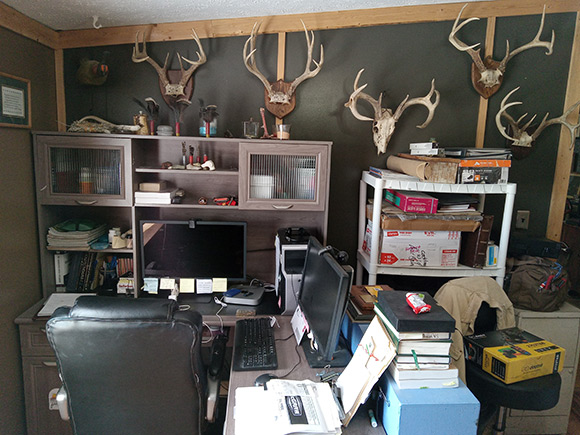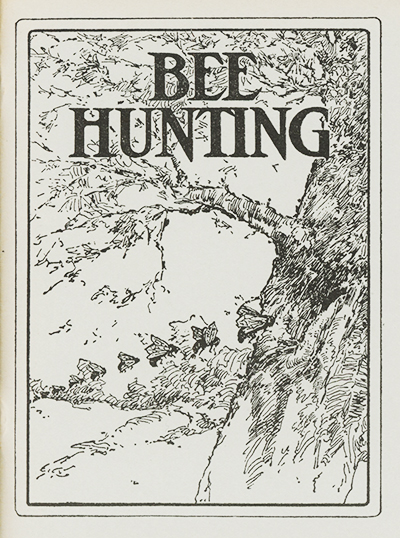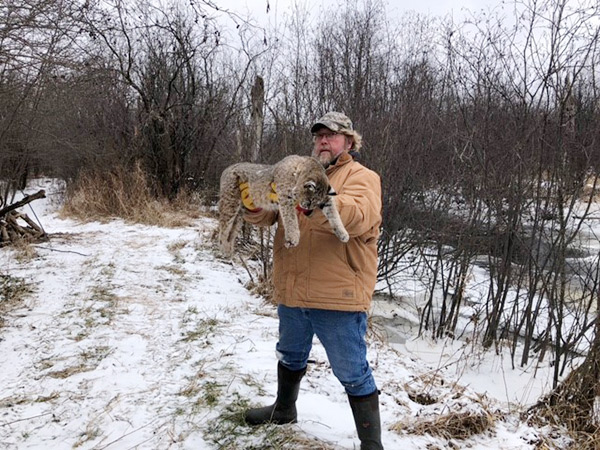 Team Fur News - Jul24
Team Fur News - Jul24
Trophies
By FUR-FISH-GAME Editor, John D. Taylor
The "trophy" room. (click photo for larger version)
My single experience with taxidermy proved disappointing, so I’ve not had anything mounted since. Back several decades ago, when I became a fly-fishing-for-trout purist, I caught a spectacular 18-inch, honey yellow, wild brown trout from a Mifflin County, Pennsylvania limestone stream. My folks suggested I get it mounted. They’d spring for the cost as a Christmas present. I took photos of the trout shortly after creeling it (yes, it was tasty) and these were passed on to the taxidermist for reference. He was also specifically told this was not a hatchery trout, but a honey yellow-colored wild brown, a stunningly beautiful fish.
What came back at Christmas was a dark, muddy hatchery brown trout, not the representation of the wild fish I’d pulled from that creek. It held little meaning for me, despite putting it up where my folks might see it.
Since then, I’ve created some “mounts” – you might call them trophies – of my own. I see them when I look up from the computer where FUR-FISH-GAME is created, adorning a dark taupe-colored, but far from an ordinary, wall. That wall contains the memories of a lifetime of outdoor experiences.
On the top shelf in front of the wall, is a dancing prairie chicken decoy, once used by biologists to lure prairie chickens to leks and observe them, contributing to their conservation. It was a gift from friends in a conservation group. I treasure it because I am passionate about prairie grouse, conserving the species, the places they live, and the things I associate with hunting them.
In front of the decoy are some bundles of sage and a freshwater oyster shell. I occasionally burn the sage in the shell because it cleanses the air, I like the scent and it’s supposed to remove negative energies – if you believe in that, and I mostly do, although computer heebie-jeebies make me wonder about sage’s cleansing abilities.
North of the oyster shell is a birchbark container from my grandmother, three shotshells filled with long gobbler beards and a dried, pink gobbler leg. I’d like to say I recall each individual bird but can’t. Many gobblers have strutted their last in front of my shotgun, and these are representative of them all, a measure of how far I’ve come as a turkey hunter. The leg was to show to kids, and I just can’t toss it. So, it struts, hopping along the shelf.
The wall behind these things holds five sets of deer skull plates and antlers, four whitetails and a mule deer. All but one came from South Dakota, the land I love.
The buck furthest south on the wall was one of two whitetails I spotted driving into a West River Walk-In on a blustery, late afternoon, mid-November 2014 rifle season opener. The rack buck and his doe were feeding along the edge of a partially harvested cornfield. Seeing my truck, they bolted into the corn.
Whitetails like to put obstacles between themselves and danger. So, I speculated these deer weren’t very deep into the standing corn. With the roaring wind covering my approach, I might be able to slip up on them.
I parked at the first pull off, entered the corn where I saw them jump in, and began stalking across the rows. Both deer were bedded, wind at their backs, in separate rows about 100 yards into the standing corn. The buck was closer. I ranged him, 135 yards, carefully went prone, dropped my rifle’s bipod legs, and settled the scope’s crosshairs on his tiny exposed vital zone. A perfect shot ended the stalk. The buck wore a symmetrical, high and tight 5 x 5 (western count) rack. How I hunted this deer, my stalk and the shot, made it special to me.
Beside the cornfield buck are 4 x 4 mule deer antlers from 2016. It’s no spectacular rack, but I’m darn proud of that hunt, too.
When I drew an any-deer tag for Fall River County, South Dakota, I knew finding a good muley would be a challenge. On the mid-November rifle opener, I watched the sun rise over the Buffalo Gap National Grassland, near ghost town Ardmore, and began “sliding” across the prairie, glassing for deer. Sliding is a way of moving that’s sort of like still hunting through a forest, except the movement is faster and terrain and topography, instead of trees and brush, conceal movement. You peek around hills, make sure you don’t skyline, move quietly and glass everything to locate game.
I spotted a small herd of muley does feeding into the wind, the buck behind them. So, I dropped into a small draw, and hurried to a spot where I might intercept the deer. When I peeped up over the draw’s rim, the deer were headed my way. The buck was 450 yards out, beyond my ability, when I first ranged him. I was shooting my new Winchester Model 70 Sporter in .25-06 with a 4x -12x Leupold scope. I unfolded the bipod legs, lay prone on the lip of the hill and waited. He was magnificent, watching him through my scope, the rising sun lighting his coat and rack like a beacon.
When he trotted to catch up with his harem, I ranged him at 275 yards, within my 300-yard comfort zone. The crosshairs settled, I squeezed the trigger, and a short while later I walked up to my first muley buck, taken fair and square on his terms in his country.
North of the muley is the full skull and rack of a huge whitetail buck, a nine-point by Eastern count, that I stumbled across 30 years ago in Michaux State Forest. It dwarfs the other antlers on my wall with massive beams and big tines. What killed this deer is unknown. I found the whole white skeleton, largely undisturbed, bones stripped clean, apparently there for several years. The antlers hadn’t been gnawed on and all the brain material was long gone. I treasure this because it came from Michaux State Forest, the South Mountains. They were my Black Hills – a sacred, holy place, full of wonder and mystery – when I lived in Pennsylvania. That Biblical line about lifting your eyes up into the hills and drawing strength, that was my relationship with those mountains.
Two more racks are north of the South Mountain skull. The top one belonged to the biggest whitetail I’ve ever tagged, a 2012 Mellette County Walk-In prairie deer I outsmarted.
Visualize a big hill in the middle of other rolling prairie hills, encircled with connected draws, wet sometimes, so a cottonwood and some brushy plum thickets could offer whitetails the cover they'd need. Add other hills, some brushed in vegetation and cedars, some mostly grass – perfect prairie whitetail habitat, especially with adjacent ranch hayfields.
My binoculars found a small herd of whitetails milling around in a plum-brushy draw at the base of a cottonwood below the big hill. They busted me and bolted before I could do anything, white tails flashing, deeper into the draw, putting the big hill between me and them. I figured to climb the big hill and “cut’em off at the pass” as they ran the draw. I did this, but again got busted, the deer bolting, before I could do anything. They continued down the draw, looping around the big hill, using the brush for cover.
It was from that hilltop that I deciphered their tactics. They’d run the connecting draws looping the big hill, a circuit of several miles, all day long to avoid a hunter, classic whitetail circling behavior. So, I pulled out to hunt a nearby area, deciding to return the next day.
Next morning, I again found them at the base of the cottonwood in the same draw. I let them bust me, saw them start down the draw. This time, however, I backtracked, looped around the draw the opposite way the deer were going.
We sort of collided, the deer and I. True to form, some of the herd bolted back up the draw, others, confused about which way to go, trotted into sparser brush in the draw in front of me.
That’s when I saw a huge old buck with a wide rack. No time to think. Take the shot now or not.
I did, and when I walked up to the downed deer, I found a huge, bull-bodied buck with a rut-thick neck. Age and several back-to-back drought years probably reduced his antler growth. He wore a very wide, but skinny 4 x 4 configuration. When I tried to move him to field dress him, I couldn’t. I guessed he went 200 pounds. Yet it wasn’t his antlers that made this buck memorable, it was that hunt, how I’d entered his world and outsmarted this deer.
The final rack is probably my best in terms of scores and numbers and other ways to measure a buck’s individuality. He was an East River, Walworth County, 6 x 4 whitetail who lived high on the hog between farm country and a big, Walk-In, cattail-filled slough. He bedded in the slough – something I figured out following deer sign in the snow that weekend – and spent his days feeding on private-farmlands crops surrounding the slough.
I caught him trying to slip back into the slough late in the afternoon. I was slowly, purposely sliding along the fence line between the slough and farm fields. With the wind in my face, I expected deer.
When I saw a big deer walking down from the crop fields, toward the slough, I quickly sat down in the bluestem grass, extended the bipod arms on my .25-06 to shoot from a sitting position, and waited for the deer to cross the fence.
He was well inside the fence line when the crosshairs settled and I squeezed the trigger. The buck fell in a small copse of stubby trees 50 yards inside the fence.
Trophies and hunters have been getting a bum rap lately. Do my antlers or turkey beard shotshells represent a trophy? I could call them that. Yet a trophy is in the eye of the beholder.
Some think Junior’s shiny baseball league or Sis’s soccer trophy is acceptable, but a mounted game head is not. Why? The mount may represent years of hard work and overcoming incredible adversity to acquire it. The non-hunting public seems to think that hunters step outside the door, raise their rifle or bow and bring down Bambi’s record-book daddy, no sweat. Real hunters know it doesn’t work that way.
Yet those of us who hunt must also acknowledge that poor behavior in our ranks tarnishes our image as conservationists. Hunting is not a competition sport, it’s not inches of antler, bigger horns, or the number of dead things piled up that count. It’s a personal endeavor – and I would seriously argue a spiritual one – where a hunter tries to enter a foreign environment (few live hand-to-mouth with no roof over our heads in the woods, on a mountaintop, a desert, or prairie’s grasslands) understand how its pieces relate and overcome the well-honed senses of wild creatures that typically elude us. Hunting should be about the experience, not necessarily the result. That’s where what hangs on my wall draws its meaning, its true value.
Firefly Conservation
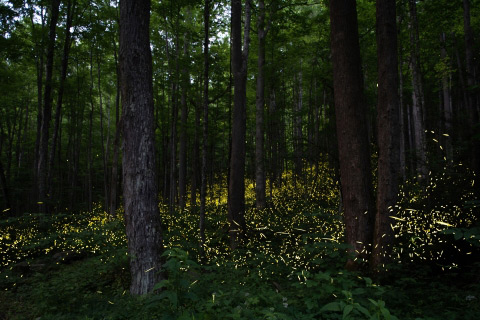
Fireflies, which are not flies but members of the beetle family, light up
the night in the Great Smoky Mountains National Park.
Photo: Shawn Rosinski/Share the Experience Photo Contest/USFWS
According to the U.S. Fish and Wildlife Service (FWS), North America has more than 100 species of fireflies. However, this may be changing. Butterflies, bees, and now fireflies, are all struggling to find places to live and reproduce. Across the country – the world – people are wondering where the fireflies went. Those who remember spectacular light shows they saw as kids now report they have subsided. These observations have been verified by numerous scientific studies which cite massive population declines in insects. Both the public, and scientists alike, are curious to know how our actions are affecting this major center of the food web. It’s estimated that we’ve already lost up to 10% of our insects since the Industrial Revolution. In 2012, the National Science Foundation found the economic value of insects totaled $34 billion. Protecting insects means protecting all animals who depend on them – including human beings. Why are fireflies not as common as they used to be? There are many reasons, FWS says: Light pollution interferes with their mating rituals, lowering reproductive success. Habitat loss, mainly of leaf litter and tall grasses, reduces the food and space available – halting, and reversing population growth. Pesticide exposure can disrupt their metabolism and development while in egg and larval life stages. Climate change adds stress by exasperating all these threats, particularly through drought and sea level rise.
How can you help your backyard and streetside insects? FWS recommends the following:
• Turn off outdoor lights in the evening. If you have inside lights on, close the blinds
• Plant native plants, and mow your grass less frequently, raising the cut length to 4 inches.
• When leaves drop in the fall, rake them if you want, but keep them in your yard
• Use non-pesticide solutions for insect control. Also, in winter, know how much salt is necessary to de-ice sidewalks, but don’t over-do it. You might even contact your city about reducing or finding alternatives to salt.
• Watch insects closely, enjoy their presence and learn about their bodies and behaviors. Show others, particularly kids, how insects are interesting not intimidating
You can make a difference, and with everyone’s help, another generation can all fall asleep to 10 million fireflies. Visit www.fws.gov/story/2021-09/backyard-insects-and-pollinators.
Spring Turkey Results
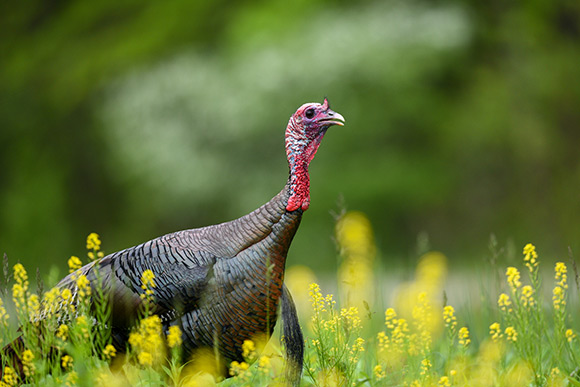
Spring gobbler hunters in three states appear to have had good seasons. Photo: ODNR photo
Three states have tallied their spring wild turkey hunting numbers and shared their results:
• Ohio – More than 51,000 spring turkey hunters checked 15,535 birds during the spring 2024 season which concluded on May 26, says Ohio’s Department of Natural Resources (ODNR) Division of Wildlife. This total includes all turkeys checked from April 20 to May 26, along with the 1,785 birds taken during the two-day youth season, April 13 and 14. During the 2023 season, 15,673 turkeys were checked, and the three-year average for the spring season (2021 - 2023) is 14,030. The top 10 2024 counties were Ashtabula (470), Belmont (454), Tuscarawas (449), Monroe (447), Washington (410), Gallia (400), Muskingum (397), Trumbull (396), Meigs (381), and Columbiana (377).
• Adult male turkeys made up 82% of the final count with 12,778 birds taken. Following above-average brood production summers in 2021 and 2022, biologists expected a high proportion of adult birds in the total harvest this spring. Hunters checked 2,595 jakes in 2024, 17% of birds taken, and 162 bearded hens during the 2024 season.
• Wisconsin – Nearly 225,630 Wisconsin turkey hunters registered 50,435 birds for the 2024 spring season, says Wisconsin’s Department of Natural Resources (DNR). This was the fourth-highest spring harvest on record and a 22% increase from the five-year average. Learn more about Wisconsin turkey hunting at dnr.wisconsin.gov/topic/hunt/turkey.
• West Virginia — According to preliminary data from West Virginia’s Division of Natural Resources (WDNR), hunters tagged 11,650 bearded turkeys during the 2024 spring gobbler season. This is fewer birds compared to 2023’s total of 12,217. Yet WDNR says the 2024 harvest was above long-term indicators and came in 6 percent higher than the five-year and 10-year average of 10,937 and 10,913, respectively. The top five counties in terms of turkey harvests were Mason (501), Preston (441), Jackson (400), Marshall (337) and Harrison (336) counties. To learn more about hunting in West Virginia visit WVdnr.gov.
Eastern Indigo Release in Conecuh National Forest

ADCNR’s Traci Wood releases an Eastern indigo snake in the
Conecuh National Forest. Photo: ACDNR photo
A project to restore the Eastern indigo snake to Alabama is one step closer to its goal with the release of 40 indigos in the Conecuh National Forest in May. The reintroduction project aims to establish a viable population of this threatened species within its historic range along Alabama’s Gulf Coast. Representatives from the Alabama Department of Conservation and Natural Resources (ADCNR), Auburn University, U.S. Forest Service, U.S. Fish and Wildlife Service, Zoo Atlanta and the Orianne Center for Indigo Conservation at the Central Florida Zoo attended the indigo release in southern Alabama. The Eastern indigo project started in 2006 and was able to start releasing captive-raised indigos in 2010 with 17 adult snakes released into the Conecuh National Forest. The goal is to release 300 snakes to improve the chances of establishing a viable population. The current reintroduction project is modeled on work started by late Auburn University professor Dr. Dan Speake in the 1970s and 1980s. During the last 14 years, a total of 284 indigos were released in the Conecuh National Forest. After being released, researchers monitor the snakes’ movements with tracking devices called PIT (passive integrated transponder) tags. They also monitor the snakes with game cameras stationed at gopher tortoise burrows which are utilized by a number of animals, including indigos. The Eastern indigo snake is a protected and threatened species throughout its historic range, in southeast Mississippi, south Alabama, the Florida panhandle and parts of south Georgia. This region was once covered with longleaf pine forest, one of the most biologically diverse habitats in North America. A recent study by herpetologists determined the 84,000-acre Conecuh National Forest has more species of amphibians and reptiles than any public land unit in the country. A decline of coastal longleaf pine habitat in the early 1900s led to the disappearance of the indigo from Alabama’s landscape. Prior to current reintroduction efforts, the last wild indigo snake observed in Alabama was in the 1950s. Longleaf pine restoration efforts throughout the indigo’s range have helped make reintroduction efforts possible. Since 2020, two wild-born indigos have been confirmed in Alabama because of the reintroduction project. For more information about the Eastern indigo snake visit https://www.outdooralabama.com/non-venomous-snakes/eastern-indigo-snake.
CWD Now in California
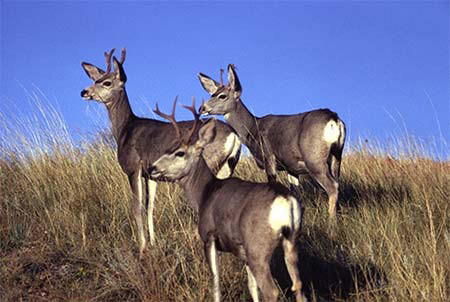
California verified its first case of CWD in May Photo: AGFD
Chronic wasting disease (CWD) has been detected for the first time in California’s deer and elk. The California Department of Fish and Wildlife (CDFW) received confirmation in early May that samples collected from two deer, one in Madera County near Yosemite Lakes and the other in Inyo County, near Bishop were CWD positive. The deer in Madera County was found dead due to unknown causes and the Inyo County deer was found dead after a vehicle collision. CWD is a fatal neurologic disease in cervid animals such as deer, elk, moose and reindeer that has been detected in free-ranging cervids from 34 states, including California, five Canadian provinces and Scandinavia. It affects the brain, causing progressive damage and eventually, death. There is no treatment or vaccine to combat this disease. There appears to be no known link between CWD and human disease, although a similar prion animal disease, bovine spongiform encephalopathy (BSE) in cattle, has been linked to fatal disease in humans through the consumption of infected beef. CDFW has been monitoring California elk and deer populations for CWD through lymph node sampling, testing more than 6,500 deer and elk, since 2000. The disparate locations of these two detections indicates CWD has probably been in California for some time, since the incubation period can be months to years. CDFW will continue to provide surveillance, response, long-term management plans and public outreach and education through their “No Time to Waste” campaign to limit the spread of CWD. Hunters can help by voluntarily participating in statewide sampling efforts and encouraging other hunters to participate. Visit wildlife.ca.gov for more information.
You Get A Free Book! And YOU Get A Free Book!
Order any FUR-FISH-GAME merchandise in the month of July and get a free copy of the classic Harding trapping book, Bee Hunting, by John R. Lockard. That's it. No catch. If you order over the phone be sure to mention you saw it here.
Multi-State Allegheny Woodrat Conservation Effort
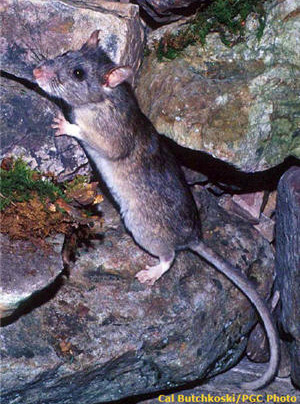
An Allegheny woodrat. Photo: Cal Butchkoski/PGC
Allegheny woodrats are a woodrat species that live only in the Appalachian Mountains. Habitat specialists, they require rocky outcrops and talus slopes embedded within healthy forests with plentiful food. In the past, Allegheny woodrat range extended from southwestern Connecticut west to Indiana and south to northern Alabama. Forest habitat fragmentation, the loss of food sources due to invasive species, a highly fatal parasite spread by raccoons, and increased populations of native food competitors like deer, bears and squirrels are among the factors that have caused range-wide declines of woodrat populations, including a 70% decline in Pennsylvania alone during the past 40 years. These animals are now listed as endangered in Indiana, Ohio, Maryland, New Jersey and New York; and as a species of conservation concern in Pennsylvania, Virginia, Tennessee, Kentucky, North Carolina, and West Virginia. As a result, these states and their university and zoo partners have come together to form the Allegheny Woodrat Working Group to coordinate a range-wide recovery effort and prevent federal listing of the species.
Allegheny woodrats don’t hibernate. Instead, they build a cache of food to survive the winter, also collecting non-food items like bottle caps, snake skins and shotgun shells, like packrats. Although called a "rat," the Allegheny woodrat looks more like a mouse. It’s gray above with white underparts and paws; has noticeably larger ears and eyes; a larger, heavier head; a bicolor, furred tail; and much longer whiskers. Average adults weigh less than a pound and are about 17 inches long, including the 8-inch tail.
Recently, the Pennsylvania Game Commission, the Maryland Zoo and the University of Pennsylvania School of Veterinary Medicine’s Wildlife Futures Program, members of the Allegheny Woodrat Working Group, teamed up to start a Woodrat Captive Breeding Program (WCBP) to rebuild struggling populations of Allegheny woodrats. Through the program, a small number of wild animals will form a founding colony at Maryland Zoo. The first such woodrat, a female from Mifflin County, Pennsylvania, turned out to be pregnant and subsequently gave birth to three pups at the Zoo. Ultimately, she will be joined by woodrats from Virginia and Indiana to breed subsequent generations. Habitat improvement at woodrat sites throughout the Appalachians is also ongoing. The goal of the WCBP is to produce genetically diverse woodrats that can be reintroduced back to the wild to improve genetic diversity of remaining woodrat populations.
North Dakota Electronic Posting System
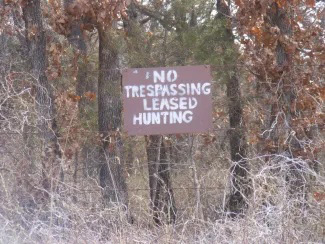
North Dakota has a system where landowners can electronically post their property. Photo: ODWC
Landowners interested in posting private land electronically for the 2024-25 hunting season can log into “My Account” on the North Dakota Game and Fish Department’s (NDGFD) website gf.nd.gov and electronically post their property. The deadline for landowners to digitally post land is July 1, which enables Game and Fish to produce print material and digital content prior to hunting seasons that begin in August. Landowners who enrolled land electronically last year can renew, add or modify posting designations during the enrollment period. The electronic posting system is linked to land descriptions based on county tax parcel information. The NDGFD website has complete instructions for landowners, along with frequently asked questions for both landowners and hunters. Visit gf.nd.gov/help?term_node_tid_depth=515
Cicadas Emerging in Wisconsin
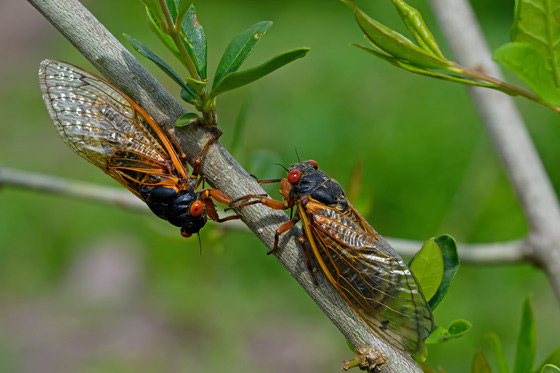
Cicadas were confirmed emerging in Wisconsin in mid-May. Photo: WDNR photo
The Wisconsin Department of Natural Resources (WDNR) confirmed the emergence of cicadas in mid-May in Wisconsin. A Lake Geneva resident sent photos of newly emerged cicadas and WDNR confirmed these insects are Brood XIII cicadas. Periodical cicadas are found in the eastern half of the United States and nowhere else. There are seven species of cicadas. Four have 13-year life cycles, three have 17-year cycles. Of those, there are 15 “broods” or year classes. The 17-year Brood XIII is the only one known to emerge in Wisconsin, though only in the southernmost counties. However, other parts of the Midwest, like Illinois and even further south, will see the emergence of both Brood XIII and the 13-year Brood XIX. This will be the first time these two broods have emerged in the same year since 1803. Cicadas’ deafening mating calls can be annoying. After they mate, their carcasses can become a nuisance as they litter the ground. However, these insects do not bite or sting. Many people cook and eat cicadas calling them “tree shrimp.” When cicadas emerge, they emerge en masse. Densities of tens to hundreds of thousands of cicadas per acre can be common. The noisy insects remain active for four to six weeks after emerging, feeding by sucking plant fluids from a wide variety of deciduous plants and shrubs. This feeding generally does not injure mature plants that are otherwise healthy. The insects are expected to keep emerging in southern Wisconsin and will not appear again in the state until 2041. Individuals who spot cicadas on their property or public lands are encouraged to report the sighting on Cicada Safari (cicadasafari.org/) to help track the co-emergence of Broods XIII and XIX. For more information, visit the University of Wisconsin–Madison’s Periodical Cicadas in Wisconsin webpage, cicadas.wisc.edu.
Ohio Sandhill Crane Numbers Up
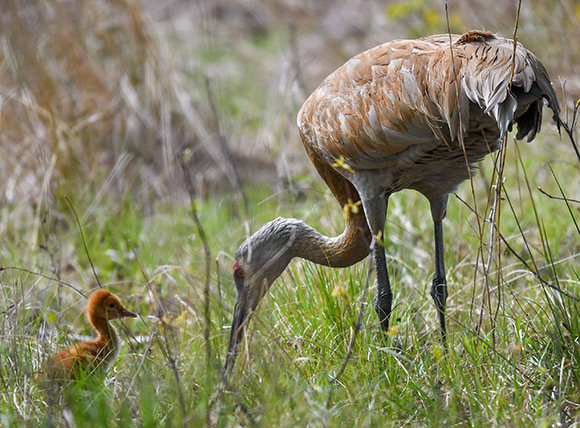
Ohio observers reported seeing 55 more Sandhill cranes during the count this spring. Photo: ODNR
Volunteer observers reported 412 sandhill cranes during the fourth annual Midwest Crane Count in April, according to the Ohio Department of Natural Resources (ODNR) Division of Wildlife. The count was coordinated by the Division of Wildlife, International Crane Foundation, and Ohio Bird Conservation Initiative. During last year’s count, volunteers observed 357 cranes. The 2024 results show a 15% increase in sightings from 2023, likely because of a growing breeding population of sandhill cranes as well as greater survey effort. Volunteers surveyed 32 counties this year and found cranes in 26 of those. The five counties with the most sandhill cranes reported during the 2024 count were Wayne (106), Lucas (56), Geauga (48), Holmes (28), and Richland (27). Sandhills were once extirpated from Ohio. They returned to Wayne County in 1987 to breed and have been slowly expanding since. They are still listed as a threatened species in Ohio. In 2021, the inaugural Midwest Crane Count found 160 sandhill cranes in five northeast Ohio counties. The survey has grown in each ensuing year. wildlife educational materials, as well as efforts to restore and conserve endangered and threatened species.
Ride Safe This Summer
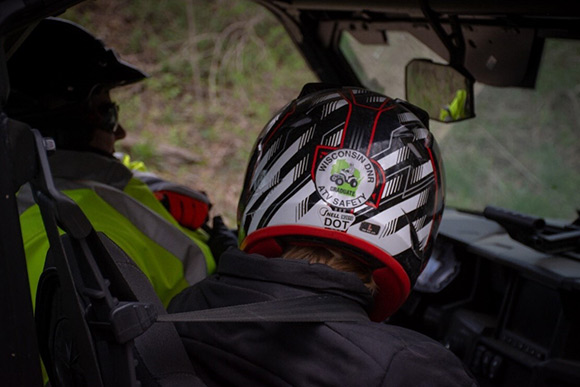
Wisconsin’s DNR wants ATV/UTV riders to complete a safety certification
course before hitting the trails. Photo: WDNR
North Dakota Duck Numbers Down
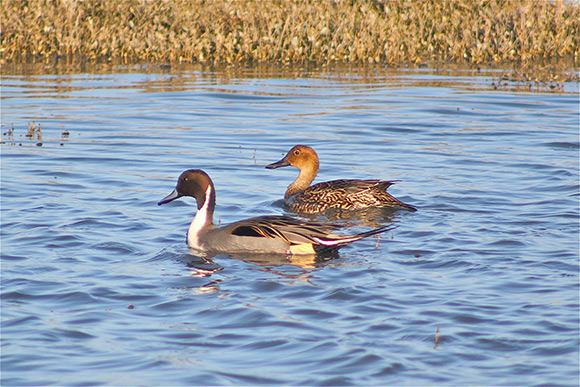
North Dakota’s spring waterfowl survey found northern pintail numbers down 29%.
Photo: Proinsias Mac an Bheatha/Unsplash
Boat Safe This Summer

Nebraska Game and Parks wants to remind boaters to brush up their
safety rules this summer Photo: Jonath Jo/Unsplash
• Check equipment — Before you launch, ensure your boat or kayak is in good running condition and all essential equipment is present, including a life jacket for every person on board. Paddlers of kayaks or canoes also should physically inspect their planned take-out point to make sure it is accessible.
• Share your plans — Before leaving home, let someone know where you are going and when you expect to return. Consider carrying a cellphone in a waterproof pouch, in case an emergency occurs.
• Wear a life jacket — Make your life jacket a statement piece and wear it. It does no good stowed away in an emergency. Children under 13, those using personal watercraft and those being towed on skis or similar device must wear a U.S. Coast Guard-approved personal flotation device. Life jackets also are required for all paddleboard users, no matter their age.
• Watch your surroundings — According to the National Safe Boating Council, nearly a quarter of all reported boating accidents in 2022 were caused by operator inattention or improper lookout. Pay attention to other boats, personal watercraft, swimmers, stumps and other hazards. Speeds more than 5 mph are prohibited within 30 yards of any other vessel, swimming area or dock. If padding a kayak or canoe, be aware of possible debris below the surface or under bridges.
• Safety equipment — Life jackets, throw cushions, fire extinguishers and bailing devices are required on most boats. An engine-cut-off device or switch also is a good idea.
• Avoid alcohol — Nearly a third of recreational boating fatalities occur when someone is boating under the influence, a criminal violation in Nebraska. Always designate a sober driver.
• Weather — Storms can pop up quickly. Check the weather in advance and monitor it during the day, if necessary.
• Hypothermia — Even in sultry temperatures, the water still can be cold. Take caution to prevent hypothermia, the lowering of internal body temperature to a dangerous level.
• Keep it legal — Make sure you’ve registered your boat and, if a nonresident, purchase an Aquatic Invasive Species stamp at OutdoorNebraska.gov. Anyone operating a motorboat or personal watercraft in Nebraska must be at least 14. Learn more about Nebraska’s boating regulations at OutdoorNebraska.gov.
Upcoming Events
New England Trappers Weekend - The New England Trappers Weekend will be held August 15 – 17 in Bethel, Maine. Contact Neil Olson at (207) 875-5765 – landline, or (207) 749-1179 – cell.
West Virginia Trappers Convention - The West Virginia Trappers Association will hold their 55th Annual Trappers Convention on September 20 - 21, at the Gilmer County Recreation Center, located at 1365 Sycamore Run Road, in Glenville, West Virginia. Admission is free. Gates open at 9 a.m. Friday and 8 a.m. Saturday. For a list of vendors and more information, visit www.wvtrappers.com or contact Jeremiah Whitlatch (304) 916-3329.
Minktoberfest – Mink trappers will want to make the trek to Punxsutawney, Pennsylvania, October 3 through 6 to participate in this event, which offers a “peer learning experience” for trappers. Pre-registration is required, and the cost is $325, with meals included. Attendees are responsible for their own accommodations. Hip boots or waders are recommended. For more information or to register, contact Don Powell at (814) 938-3031.
Texas Trappers and Fur Hunters Association Fall Rendezvous – The Texas Trapper Texas Trapper and Fur Hunters Association will hold their Fall Rendezvous October 18 and 19, at the Gatesville Civic Center, 301 Veteran's Memorial Loop, in Gatesville, Texas. The event includes demonstrations, live auction, and more. For more information, visit www.ttfha.com or call Matt Carter (830) 505-0033
What’s Coming in August
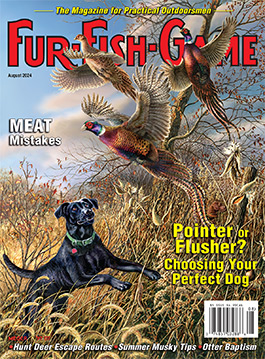
Feature Articles
Beach Bums & Pier Rats – Phil Goes – Phil and family go on a beach vacation in South Carolina and ends up fishing, naturally.
Full Packs and Caribou Tracks – Noah Meierotto – A father/daughter caribou hunt in Alaska’s Tanana River valley yields insights, beauty... and meat.
Hunt the Escape Routes – W. D. Baker – Want to be a better deer hunter? Then look for and hunt whitetail escape routes. Their locations may surprise you.
Pointer or Flusher? – Alan Davy – Considering a gun dog? Here are a few considerations to make the best choice that suits your hunting and your lifestyle.
Meat Mistakes – David Darlington – A Wyoming hunter learns from his mistakes how to get the most out of game meat through careful processing during the hunt.
Other Stories
• The Art of Duck Sneaking – Ron Peach shares how he sneaks up on ducks when the decoys are working.
• Wolves of the Birchwood, Chapter 1, Part 1 – A new Lew & Charlie adventure begins.
• One-Two Punch for Summer Muskies – Rob Dankowksy shares his secrets for catching huge midsummer muskies.
• Getting Young People Outdoors – Jeffrey Miller tells how South Dakota Youth Hunting Adventures and similar programs across the nation are getting young people into the outdoors.
• The Otter Baptism – Phil Goes shares his first otter experience and learns some things as he gains experience otter trapping.
• Open Water Muskrats – Andrew Zysek offers some tips to for trapping marsh muskrats.
• The Hellgrammite Roll – Lou Gocek shares how hellgrammites, the larvae of the Dobsonfly, can become a highly effective fishing bait.
• Back Country – James Phelps tells how, as boys, he and a friend, in 1969, set out for two high country Montana lakes to fish and enjoy themselves.
End of the Line Photo of the Month
Brad Schancer, Hawkins, Wisconsin
SUBSCRIBE TO FUR-FISH-GAME Magazine

